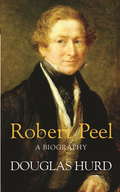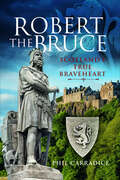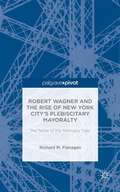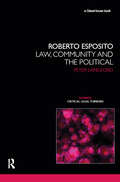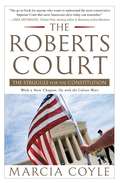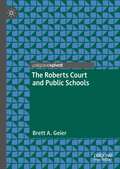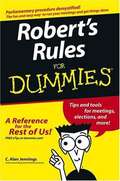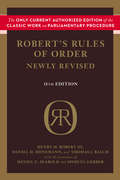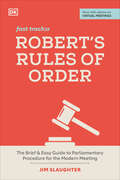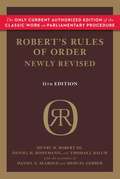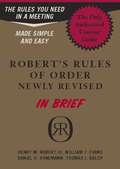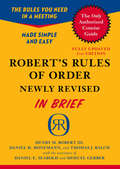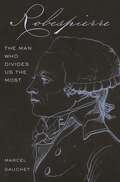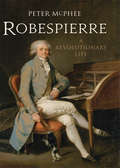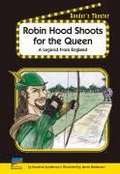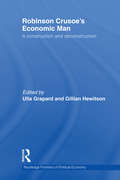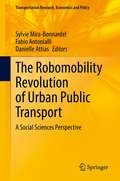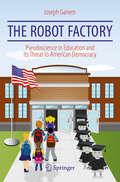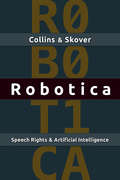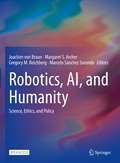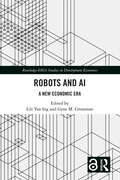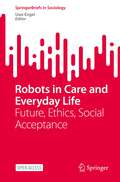- Table View
- List View
Robert Peel: A Biography
by Douglas HurdThe life of one of the greatest British Prime Ministers - by an author who knows the scene from his years as a senior Minister in Margaret Thatcher's Cabinet.Robert Peel (1788-1850), as much as any man in the nineteenth century, transformed Great Britain into a modern nation. He invented our police force, which became a model for the world. He steered through the Bill which allowed Catholics to sit in Parliament. He reorganised the criminal justice system. Above all he tackled poverty by repealing the Corn Laws. Thanks to Peel the most powerful trading nation chose free trade and opened the door for our globalised world of today.Peel was not all politics. He built two great houses, filled them with famous pictures and was devoted to a beautiful wife. Many followers never forgave him for splitting his Party. But when in 1850 he was carried home after a fall from his horse crowds gathered outside, mainly of working people, to read the medical bulletins. When he died a few days later, factories closed, flags flew at half-mast and thousands contributed small sums to memorials in his honour. He was the man who provided cheap bread and sacrificed his career for the welfare of ordinary people.
Robert Peel: A Biography
by Douglas HurdThe life of one of the greatest British Prime Ministers - by an author who knows the scene from his years as a senior Minister in Margaret Thatcher's Cabinet.Robert Peel (1788-1850), as much as any man in the nineteenth century, transformed Great Britain into a modern nation. He invented our police force, which became a model for the world. He steered through the Bill which allowed Catholics to sit in Parliament. He reorganised the criminal justice system. Above all he tackled poverty by repealing the Corn Laws. Thanks to Peel the most powerful trading nation chose free trade and opened the door for our globalised world of today.Peel was not all politics. He built two great houses, filled them with famous pictures and was devoted to a beautiful wife. Many followers never forgave him for splitting his Party. But when in 1850 he was carried home after a fall from his horse crowds gathered outside, mainly of working people, to read the medical bulletins. When he died a few days later, factories closed, flags flew at half-mast and thousands contributed small sums to memorials in his honour. He was the man who provided cheap bread and sacrificed his career for the welfare of ordinary people.
Robert the Bruce: Scotland's True Braveheart
by Phil CarradiceRobert the Bruce is a detailed account of the life and times of the Scottish hero and monarch. It covers his life from childhood to death, looking at the political, social and military life of Scotland before, during and after the time of Robert the Bruce. The book looks at the relationship between The Bruce and people like Edward I and Edward II of England, William Wallace and the other contenders for the Scottish crown. The main thrust of the book is a chronological account of how The Bruce clawed his way to power, his struggles and battles and his eventual victory which gave Scotland independence and freedom from an acquisitive and warlike neighbour. It looks in detail at the murder of John Comyn, of which The Bruce stood accused, and the political ramifications of the killing. Robert the Bruce was no saint. He was a ruthless, cunning warrior, a man of his times, dedicated to what he saw as his mission in life. Flawed he may have been but he was also a great King, a worthy warrior and a man who deserves to emerge from the shadow of William Wallace - a position to which he has been relegated ever since the film Braveheart.
Robert Wagner and the Rise of New York City’s Plebiscitary Mayoralty: The Tamer of the Tammany Tiger
by Richard M. FlanaganRobert Wagner was New York City's true New Deal mayor, killed Tammany Hall. The world Wagner shaped delivers municipal services efficiently at the cost of local democracy. The story of Wagner's mayoralty will be of interest to anyone who cares about New York City, local democracy and the debate about the legacy of the City's important leaders.
Roberto Esposito: Law, Community and the Political (Nomikoi: Critical Legal Thinkers)
by Peter LangfordRoberto Esposito: Law, Community and the Political provides a critical legal introduction to this increasingly influential Italian theorist’s work, by focusing on Esposito’s reconceptualisation of the relationship between law, community and the political. The analysis concentrates primarily on Esposito’s Catégories de l’Impolitique, Communitas, Immunitas and Bíos, which, it is argued, are animated by an abiding concern with the position of critique in relation to the tradition of modern and contemporary legal and political philosophy. Esposito’s fundamental rethinking of these notions breaks with the existing framework of political and legal philosophy, through the critique of its underlying presuppositions. And, in the process, Esposito rethinks the very form of critique. As the first monograph-length study of Esposito in English, Roberto Esposito: Law, Community and the Political will be of considerable interest to those working in the areas of contemporary legal and political thought and philosophy.
The Roberts Court: The Struggle for the Constitution
by Marcia CoyleThe Roberts Court, seven years old, sits at the center of a constitutional maelstrom. Through four landmark decisions, Marcia Coyle, one of the most prestigious experts on the Supreme Court, reveals the fault lines in the conservative-dominated Court led by Chief Justice John Roberts Jr.Seven minutes after President Obama put his signature to a landmark national health care insurance program, a lawyer in the office of Florida GOP attorney general Bill McCollum hit a computer key, sparking a legal challenge to the new law that would eventually reach the nation's highest court. Health care is only the most visible and recent front in a battle over the meaning and scope of the U.S. Constitution. The battleground is the United States Supreme Court, and one of the most skilled, insightful, and trenchant of its observers takes us close up to watch it in action. Marcia Coyle's brilliant inside account of the High Court captures four landmark decisions--concerning health care, money in elections, guns at home, and race in schools. Coyle examines how those cases began--the personalities and conflicts that catapulted them onto the national scene--and how they ultimately exposed the great divides among the justices, such as the originalists versus the pragmatists on guns and the Second Amendment, and corporate speech versus human speech in the controversial Citizens United campaign case. Most dramatically, her analysis shows how dedicated conservative lawyers and groups are strategizing to find cases and crafting them to bring up the judicial road to the Supreme Court with an eye on a receptive conservative majority. The Roberts Court offers a ringside seat at the struggle to lay down the law of the land.
The Roberts Court
by Marcia CoyleThe Roberts Court--seven years old, with a predominantly 5-4 conservative/liberal split--sits at the center of a constitutional maelstrom. Marcia Coyle, one of the most prestigious experts on the Supreme Court, reports on its direction under Chief Justice Roberts, as she traces the paths and resolutions of five landmark decisions on race, guns, immigration, campaign finance, and health care.Coyle recounts how a smart group of conservative lawyers has crafted cases with an eye towards an increasingly receptive conservative majority. She describes the long paths these cases take to reach the Court, and how their resolutions expose the political divisions among the justices: originalists v. pragmatists on guns and the Second Amendment; "corporate money is speech" v. "corporate money is not speech"; and state vs. federal powers in the cases of immigration and health care. As Bob Woodward laid bare the inner workings of the Supreme Court in The Brethren (in the transition from Warren to Burger), Coyle demonstrates how the direction of the Roberts Court is powerfully affecting the nation's political argument and its future.
The Roberts Court and Public Schools
by Brett A. GeierThis unique and timely book offers a synthesis, analysis, and evaluation of education-related rulings of the US Supreme Court from 2005 to the present. Throughout the course of the twentieth century into the twenty-first century, the Supreme Court issued rulings, which frequently vacillate based on the political composition of the justices who sit on the bench. Chapters will cover both an overview of the role of Supreme Court rulings in school policy and the court’s transformation in the late twentieth century into the present day. These themes will be converted into robust chapters which will provide a legal analysis of the Roberts Court years, and an evaluation of the jurisprudence and its practical effect on public schools.
Robert's Rules for Dummies
by C. Alan JenningsNeed to read up on Robert's Rules? Relax! This clear, easy-to-use guide makes parliamentary procedure simple to understand and apply.
Robert's Rules of Order
by Henry M. Robert III"Robert's Rules of Order" is "the" book on parliamentary procedure for parliamentarians and anyone involved in an organization, association, club, or group and the authoritative guide to smooth, orderly, and fairly conducted meetings and assemblies. This newly revised edition is the only book on parliamentary procedure to have been updated since 1876 under the continuing program of review established by General Henry M. Robert himself, in cooperation with the official publisher of "Robert's Rules. " The eleventh edition has been thoroughly revised to address common inquiries and incorporate new rules, interpretations, and procedures made necessary by the evolution of parliamentary procedure, including new material relating to electronic communication and "electronic meetings. "
Robert's Rules of Order
by Henry M. Robert III"Robert's Rules of Order" is "the" book on parliamentary procedure for parliamentarians and anyone involved in an organization, association, club, or group and the authoritative guide to smooth, orderly, and fairly conducted meetings and assemblies. This newly revised edition is the only book on parliamentary procedure to have been updated since 1876 under the continuing program of review established by General Henry M. Robert himself, in cooperation with the official publisher of "Robert's Rules. " The eleventh edition has been thoroughly revised to address common inquiries and incorporate new rules, interpretations, and procedures made necessary by the evolution of parliamentary procedure, including new material relating to electronic communication and "electronic meetings. "
Robert's Rules of Order Fast Track: The Brief and Easy Guide to Parliamentary Procedure for the Modern Meeting
by Jim SlaughterMust-Have Advice on Running Effective and Organized MeetingsEasy, accessible, and to the point. Robert's Rules of Order Fast Track gives you everything you need to know to conduct shorter, fairer, and more orderly meetings. In this new and improved update, you'll find: -The fundamentals of parliamentary procedure, with tips on knowing which rules to use for your meetings. -Simple suggestions for making, seconding, and debating motions. -A primer on voting, from knowing when it's required, to breaking ties, to handling absentee and proxy votes. -Straightforward strategies for setting and sticking to an agenda and efficiently recording your meeting's minutes. -Tips for handling disruptive members and tyrannical chairs. -All-new guidance on conducting the modern virtual meeting.
Robert's Rules Of Order (Newly Revised, 11th Edition)
by Henry M. III Robert William J. Evans Daniel H. Honemann Thomas J. Balch Shmuel Gerber Daniel E. SeaboldRobert's Rules of Order is the book on parliamentary procedure for parliamentarians and anyone involved in an organization, association, club, or group and the authoritative guide to smooth, orderly, and fairly conducted meetings and assemblies. This newly revised edition is the only book on parliamentary procedure to have been updated since 1876 under the continuing program of review established by General Henry M. Robert himself, in cooperation with the official publisher ofRobert's Rules. The eleventh edition has been thoroughly revised to address common inquiries and incorporate new rules, interpretations, and procedures made necessary by the evolution of parliamentary procedure, including new material relating to electronic communication and "electronic meetings. "
Robert's Rules Of Order Newly Revised In Brief
by Henry M. III Robert William J. Evans Daniel H. Honemann Thomas J. BalchGoing to a meeting? Want to know how to take part? Learn quickly and easily! This short, simple book includes: Sample dialogues to get you confidently through motions, nominations, elections, votes, debates, amendments, and more Invaluable tips for keeping meetings orderly and on track A chapter answering the most frequently asked questions Not sure what to do at a meeting? Handy tables at the back of the book tell you just what to say Appointed to a committee? Elected an officer or board member? Chosen as a convention delegate? Chapters on each clearly explain your duties
Robert's Rules of Order Newly Revised in Brief
by Henry M. Robert III William J. Evans Daniel H. Honemann Thomas J. BalchGoing to a meeting? Want to know how to take part? Learn quickly and easily! This short, simple book includes: Sample dialogues to get you confidently through motions, nominations, elections, votes, debates, amendments, and more Invaluable tips for keeping meetings orderly and on track A chapter answering the most frequently asked questions Not sure what to do at a meeting? Handy tables at the back of the book tell you just what to say Appointed to a committee? Elected an officer or board member? Chosen as a convention delegate? Chapters on each clearly explain your duties
Robespierre: The Man Who Divides Us the Most
by Marcel GauchetHow Robespierre’s career and legacy embody the dangerous contradictions of democracyMaximilien Robespierre (1758–1794) is arguably the most controversial and contradictory figure of the French Revolution, inspiring passionate debate like no other protagonist of those dramatic and violent events. The fervor of those who defend Robespierre the “Incorruptible,” who championed the rights of the people, is met with revulsion by those who condemn him as the bloodthirsty tyrant who sent people to the guillotine. Marcel Gauchet argues that he was both, embodying the glorious achievement of liberty as well as the excesses that culminated in the Terror.In much the same way that 1789 and 1793 symbolize the two opposing faces of the French Revolution, Robespierre’s contradictions were the contradictions of the revolution itself. Robespierre was its purest incarnation, neither the defender of liberty who fell victim to the corrupting influence of power nor the tyrant who betrayed the principles of the revolution. Gauchet shows how Robespierre’s personal transition from opposition to governance was itself an expression of the tragedy inherent in a revolution whose own prophetic ideals were impossible to implement.This panoramic book tells the story of how the man most associated with the founding of modern French democracy was also the first tyrant of that democracy, and it offers vital lessons for all democracies about the perpetual danger of tyranny.
Robespierre
by Peter McpheeFor some historians and biographers, Maximilien Robespierre (1758-94) was a great revolutionary martyr who succeeded in leading the French Republic to safety in the face of overwhelming military odds. For many others, he was the first modern dictator, a fanatic who instigated the murderous Reign of Terror in 1793-94. This masterful biography combines new research into Robespierre's dramatic life with a deep understanding of society and the politics of the French Revolution to arrive at a fresh understanding of the man, his passions, and his tragic shortcomings. Peter McPhee gives special attention to Robespierre's formative years and the development of an iron will in a frail boy conceived outside wedlock and on the margins of polite provincial society. Exploring how these experiences formed the young lawyer who arrived in Versailles in 1789, the author discovers not the cold, obsessive Robespierre of legend, but a man of passion with close but platonic friendships with women. Soon immersed in revolutionary conflict, he suffered increasingly lengthy periods of nervous collapse correlating with moments of political crisis, yet Robespierre was tragically unable to step away from the crushing burdens of leadership. Did his ruthless, uncompromising exercise of power reflect a descent into madness in his final year of life? McPhee reevaluates the ideology and reality of "the Terror," what Robespierre intended, and whether it represented an abandonment or a reversal of his early liberalism and sense of justice.
Robin Hood Shoots for the Queen: A Legend from England
by Jeannette Sanderson James Baldessari Jeffrey FuerstPerform this legend from England about a queen who wants Robin Hood to shoot for her at the king's archery tournament.
Robinson Crusoe's Economic Man: A Construction and Deconstruction (Routledge Frontiers Of Political Economy Ser.)
by Ulla Grapard Gillian HewitsonIn this book, economists and literary scholars examine the uses to which the Robinson Crusoe figure has been put by the economics discipline since the publication of Defoe’s novel in 1719. The authors’ critical readings of two centuries of texts that have made use of Robinson Crusoe undermine the pervasive belief of mainstream economics that Robinson Crusoe is a benign representative of economic agency, and that he, like other economic agents, can be understood independently of historical and cultural specificity. The book provides a detailed account of the appearance of Robinson Crusoe in the economics literature and in a plethora of modern economics texts, in which, for example, we find Crusoe is portrayed as a schizophrenic consumer/producer trying to maximize his personal well-being. Using poststructuralist, feminist, postcolonial, Marxist and literary criticism approaches, the authors of the fourteen chapters in this volume examine and critique some of the deepest, fundamental assumptions neoclassical economics hold about human nature; the political economy of colonization; international trade; and the pervasive gendered organization of social relations. The contributors to this volume can be seen as engaging in the emerging conversation between economists and literary scholars known as the New Economic Criticism. They offer unique perspectives on how the economy and economic thought can be read through different disciplinary lenses. Economists pay attention to rhetoric and metaphor deployed in economics, and literary scholars have found new areas to explore and understand by focusing on economic concepts and vocabulary encountered in literary texts.
The Robomobility Revolution of Urban Public Transport: A Social Sciences Perspective (Transportation Research, Economics and Policy)
by Sylvie Mira-Bonnardel Fabio Antonialli Danielle AttiasOver the past two decades, society has been witnessing how technological, political, and societal changes have been transforming individual and collective urban mobility. Driven both by newcomers and traditional players, by disruptive as well as incremental innovations, the main objective now is to enhance mobility and accessibility while, reducing vehicle ownership, congestion, road accidents, and pollution in cities. This transformation has been mainly enabled by the widespread adoption of internet-connected devices (e.g.: smartphones and tablets) and by the innovative business models, technologies, and use-cases that arose from this rapid digitalization, such as peer-to-peer, and two-sided markets providing several mobility schemes: car-sharing, car-pooling, bike sharing, free-floating (cars, bikes, electric scooter), ridesharing and ride hailing either for long distances as well as for urban and micro-mobility. The book presents – in a holistic perspective – how this revolution is happening and what are the major cornerstones for the implementation of robomobility. It aims at answering several substantial issues, such as: What is robomobility and what does it imply for the different stakeholders of the public transport ecosystem? How do policy makers integrate this innovation and how ready the regulations are? How do citizens take part in this transformation? What is the level of user acceptance for this new type of mobility? What are its environmental impacts? What is the economic impact of deploying these shuttles in a local ecosystem?
The Robot Factory: Pseudoscience In Education And Its Threat To American Democracy
by Joseph GanemThis book exposes a disturbing misuse of the scientific method to advance policies and agendas that are in fact detrimental to both science and education. The author, a physics professor, examines two related trends in education – the practice of “data-driven” reform and the disparaging of the traditional liberal arts in favor of programs with a heavy emphasis on science and technology. Many of the reforms being foisted on educators have more in common with pseudo-science than real science. The reduction of education to a commodity, and the shilling of science as a means to enhance corporate profits, lead to an impoverished and stunted understanding of science in particular, and of education in general.How is it possible for: • schools with all students learning at grade-level to be rated as failing?• teachers to be rated as ineffective after all their students meet their learning outcomes?• rising grade-school math standards to result in more college students needing remedial math?• politicians to disparage scientists and their results but argue that more students should study science?These bizarre outcomes have happened and are the result of an education system that misuses and misrepresents math and science in the classroom and in crafting education policies. This book exposes the flawed and fallacious thinking that is damaging education at all levels throughout the United States, and makes a compelling case for rethinking the standardized, optimized, and quantified approaches in vogue in education today to accommodate the different needs of individual teachers and students.
Robotica: Speech Rights and Artificial Intelligence
by Ronald K. L. Collins David M. SkoverIn every era of communications technology - whether print, radio, television, or Internet - some form of government censorship follows to regulate the medium and its messages. <P><P>Today we are seeing the phenomenon of 'machine speech' enhanced by the development of sophisticated artificial intelligence. <P>Ronald K. L. Collins and David M. Skover argue that the First Amendment must provide defenses and justifications for covering and protecting robotic expression. It is irrelevant that a robot is not human and cannot have intentions; what matters is that a human experiences robotic speech as meaningful. This is the constitutional recognition of 'intentionless free speech' at the interface of the robot and receiver. Robotica is the first book to develop the legal arguments for these purposes. Aimed at law and communication scholars, lawyers, and free speech activists, this work explores important new problems and solutions at the interface of law and technology.<P> Offers a new theory of First Amendment speech rights that covers robotic expression.<P> Describes the evolution of communications technologies and government efforts to censor them.<P> Proposes a First Amendment theory of utility to justify protection for robotic expression.
Robotics, AI, and Humanity: Science, Ethics, and Policy
by Margaret S. Archer Gregory M. Reichberg Joachim Von Braun Marcelo Sánchez SorondoThis open access book examines recent advances in how artificial intelligence (AI) and robotics have elicited widespread debate over their benefits and drawbacks for humanity. The emergent technologies have for instance implications within medicine and health care, employment, transport, manufacturing, agriculture, and armed conflict. While there has been considerable attention devoted to robotics/AI applications in each of these domains, a fuller picture of their connections and the possible consequences for our shared humanity seems needed. This volume covers multidisciplinary research, examines current research frontiers in AI/robotics and likely impacts on societal well-being, human – robot relationships, as well as the opportunities and risks for sustainable development and peace. The attendant ethical and religious dimensions of these technologies are addressed and implications for regulatory policies on the use and future development of AI/robotics technologies are elaborated.
Robots and AI: A New Economic Era (Routledge-ERIA Studies in Development Economics)
by Lili Yan Ing Gene M. GrossmanRobots and artificial intelligence (AI) are powerful forces that will likely have large impacts on the size, direction, and composition of international trade flows. This book discusses how industrial robots, automation, and AI affect international growth, trade, productivity, employment, wages, and welfare. The book explains new approaches on how robots and artificial intelligence affect the world economy by presenting detailed theoretical framework and country-specific as well as firm-product level-specific exercises. This book will be a useful reference for those researching on robots, automation, AI and their economic impacts on trade, industry, and employment.
Robots in Care and Everyday Life: Future, Ethics, Social Acceptance (SpringerBriefs in Sociology)
by Uwe EngelThis open access book presents detailed findings about the ethical, legal, and social acceptance of robots in the German and European context. The key resource is the Bremen AI Delphi survey of scientists and politicians and a related population survey. The focus is on trust in robotic assistance, human willingness to use this assistance, and the expected personal well-being in human-robot interaction. Using recent data from Eurostat, the European Social Survey, and the Eurobarometer survey, the analysis is extended to Germany and the EU. The acceptance of robots in care and everyday life is viewed against their acceptance in other contexts of life and the scientific research. The book reports on how the probability of five complex future scenarios is evaluated by experts and politicians. These scenarios cover a broad range of topics, including the worst-case scenario of cutthroat competition for jobs, the wealth promise of AI, communication in human-robot interaction, robotic assistance, and ethical and legal conflicts. International economic competition alone will ensure that countries invest sustainably in the future technologies of AI and robots. But will these technologies also be accepted by the population? The book raises the core issue of how governments can gain the needed social, ethical, and user acceptance of AI and robots in everyday life. This highly topical book is of interest to researchers, professionals and policy makers working on various aspects of human-robot interaction. This is an open access book.
